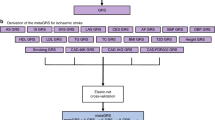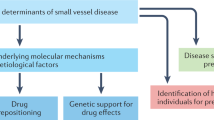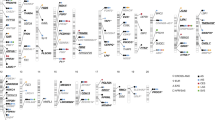Key Points
-
Genome-wide association studies (GWASs) have identified a number of novel genetic variants that are associated with a risk of ischaemic stroke
-
Most genetic variants identified in GWASs of stroke to date are associated with specific pathophysiological subtypes, including large-artery and cardioembolic stroke
-
Associations of specific genes with specific subtypes of stroke provide insight into the different pathophysiological mechanisms involved, which could lead to the development of novel therapeutic approaches
-
Insights into stroke pathophysiology provided by genetic associations suggest the need for evaluation of treatments in different subtypes and for reliable systems to classify subtypes
-
Larger GWAS cohorts and new approaches such as next-generation sequencing will identify more genetic variants associated with ischaemic stroke to further improve understanding of the disease and clinical care
Abstract
The precise pathophysiology of ischaemic stroke is unclear, and a greater understanding of the different mechanisms that underlie large-artery, cardioembolic and lacunar ischaemic stroke subtypes would enable the development of more-effective, subtype-specific therapies. Genome-wide association studies (GWASs) are identifying novel genetic variants that associate with the risk of stroke. These associations provide insight into the pathophysiological mechanisms, and present opportunities for novel therapeutic approaches. In this Review, we summarize the genetic variants that have been linked to ischaemic stroke in GWASs to date and discuss the implications of these associations for both our understanding and treatment of ischaemic stroke. The majority of genetic variants identified are associated with specific subtypes of ischaemic stroke, implying that these subtypes have distinct genetic architectures and pathophysiological mechanisms. The findings from the GWASs highlight the need to consider whether therapies should be subtype-specific. Further GWASs that include large cohorts are likely to provide further insights, and emerging technologies will complement and build on the GWAS findings.
This is a preview of subscription content, access via your institution
Access options
Subscribe to this journal
Receive 12 print issues and online access
$209.00 per year
only $17.42 per issue
Buy this article
- Purchase on Springer Link
- Instant access to full article PDF
Prices may be subject to local taxes which are calculated during checkout

Similar content being viewed by others
References
Lanfranconi, S. & Markus, H. S. Stroke subtyping for genetic association studies? A comparison of the CCS and TOAST classifications. Int. J. Stroke 8, 626–631 (2013).
Flossmann, E., Schulz, U. G. & Rothwell, P. M. Systematic review of methods and results of studies of the genetic epidemiology of ischemic stroke. Stroke 35, 212–227 (2004).
Jerrard-Dunne, P., Cloud, G., Hassan, A. & Markus, H. S. Evaluating the genetic component of ischemic stroke subtypes: a family history study. Stroke 34, 1364–1369 (2003).
Seshadri, S. et al. Parental occurrence of stroke and risk of stroke in their children: the Framingham study. Circulation 121, 1304–1312 (2010).
Khaleghi, M. et al. Family history as a risk factor for carotid artery stenosis. Stroke 45, 2252–2256 (2014).
Banerjee, A. et al. Familial history of stroke is associated with acute coronary syndromes in women. Circ. Cardiovasc. Genet. 4, 9–15 (2011).
Kennedy, R. E. et al. Association between family risk of stroke and myocardial infarction with prevalent risk factors and coexisting diseases. Stroke 43, 974–979 (2012).
Touzé, E. & Rothwell, P. M. Sex differences in heritability of ischemic stroke: a systematic review and meta-analysis. Stroke 39, 16–23 (2008).
Bevan, S. et al. Genetic heritability of ischemic stroke and the contribution of previously reported candidate gene and genomewide associations. Stroke 43, 3161–3167 (2012).
Dichgans, M. & Markus, H. S. Genetic association studies in stroke: methodological issues and proposed standard criteria. Stroke 36, 2027–2031 (2005).
Hindorff, L. A. et al. A catalog of published genome-wide association studies. National Human Genome Research Institute [online], (2014).
Woo, D. et al. Meta-analysis of genome-wide association studies identifies 1q22 as a susceptibility locus for intracerebral hemorrhage. Am. J. Hum. Genet. 94, 511–521 (2014).
Alg, V. S., Sofat, R., Houlden, H. & Werring, D. J. Genetic risk factors for intracranial aneurysms: a meta-analysis in more than 116,000 individuals. Neurology 80, 2154–2165 (2013).
Gretarsdottir, S. et al. Risk variants for atrial fibrillation on chromosome 4q25 associate with ischemic stroke. Ann. Neurol. 64, 402–409 (2008).
Gudbjartsson, D. F. et al. A sequence variant in ZFHX3 on 16q22 associates with atrial fibrillation and ischemic stroke. Nat. Genet. 41, 876–878 (2009).
Lemmens, R. et al. The association of the 4q25 susceptibility variant for atrial fibrillation with stroke is limited to stroke of cardioembolic etiology. Stroke 41, 1850–1857 (2010).
Helgadottir, A. et al. A common variant on chromosome 9p21 affects the risk of myocardial infarction. Science 316, 1491–1493 (2007).
Gschwendtner, A. et al. Sequence variants on chromosome 9p21.3 confer risk for atherosclerotic stroke. Ann. Neurol. 65, 531–539 (2009).
International Stroke Genetics Consortium (ISGC) et al. Genome-wide association study identifies a variant in HDAC9 associated with large vessel ischemic stroke. Nat. Genet. 44, 328–333 (2012).
Traylor, M. et al. Genetic risk factors for ischaemic stroke and its subtypes (the METASTROKE collaboration): a meta-analysis of genome-wide association studies. Lancet Neurol. 11, 951–962 (2012).
Han, Y. et al. HDAC9 gene is associated with stroke risk in a Chinese population. Exp. Biol. Med. (Maywood) 238, 842–847 (2013).
ENCODE Project Consortium. A user's guide to the encyclopedia of DNA elements (ENCODE). PLoS Biol. 9, e1001046 (2011).
Holliday, E. G. et al. Common variants at 6p21.1 are associated with large artery atherosclerotic stroke. Nat. Genet. 44, 1147–1151 (2012).
Traylor, M. et al. A novel MMP12 locus is associated with large artery atherosclerotic stroke using a genome-wide age-at-onset informed approach. PLoS Genet. 10, e1004469 (2014).
Kubo, M. et al. A nonsynonymous SNP in PRKCH (protein kinase C η) increases the risk of cerebral infarction. Nat. Genet. 39, 212–217 (2007).
Serizawa, M. et al. Association between PRKCH gene polymorphisms and subcortical silent brain infarction. Atherosclerosis 199, 340–345 (2008).
Ikram, M. A. et al. Genomewide association studies of stroke. N. Engl. J. Med. 360, 1718–1728 (2009).
International Stroke Genetics Consortium & Wellcome Trust Case–Control Consortium 2. Failure to validate association between 12p13 variants and ischemic stroke. N. Engl. J. Med. 362, 1547–1550 (2010).
Kilarski, L. et al. Meta-analysis in more than 17,900 cases of ischemic stroke reveals a novel association at 12q24.12. Neurology 19, 678–685 (2014).
Hassan, A., Sham, P. & Markus, H. S. Planning genetic studies in human stroke: sample size estimates based on family history data. Neurology 58, 1483–1488 (2002).
Kraft, P. & Hunter, D. J. Genetic risk prediction—are we there yet? N. Engl. J. Med. 360, 1701–1703 (2009).
FDA bans 23andme personal genetic tests. BBC News [online], (2013).
Schneider, K. I. & Schmidtke, J. Patient compliance based on genetic medicine: a literature review. J. Community Genet. 5, 31–48 (2014).
Rohrer, B. et al. A targeted inhibitor of the alternative complement pathway reduces angiogenesis in a mouse model of age-related macular degeneration. Invest. Ophthalmol. Vis. Sci. 50, 3056–3064 (2009).
Visscher, P. M., Brown, M. A., McCarthy, M. I. & Yang, J. Five years of GWAS discovery. Am. J. Hum. Genet. 90, 7–24 (2012).
Dadu, R. T. & Ballantyne, C. M. Lipid lowering with PCSK9 inhibitors. Nat. Rev. Cardiol. 11, 563–575 (2014).
Haberland, M., Montgomery, R. L. & Olson, E. N. The many roles of histone deacetylases in development and physiology: implications for disease and therapy. Nat. Rev. Genet. 10, 32–42 (2009).
Markus, H. S. et al. Evidence HDAC9 genetic variant associated with ischemic stroke increases risk via promoting carotid atherosclerosis. Stroke 44, 1220–1225 (2013).
Langley, B., Brochier, C. & Rivieccio, M. A. Targeting histone deacetylases as a multifaceted approach to treat the diverse outcomes of stroke. Stroke 40, 2899–2905 (2009).
Schunkert, H. et al. Large-scale association analysis identifies 13 new susceptibility loci for coronary artery disease. Nat. Genet. 43, 333–338 (2011).
Bowes, A. J., Khan, M. I., Shi, Y., Robertson, L. & Werstuck, G. H. Valproate attenuates accelerated atherosclerosis in hyperglycemic apoE-deficient mice: evidence in support of a role for endoplasmic reticulum stress and glycogen synthase kinase-3 in lesion development and hepatic steatosis. Am. J. Pathol. 174, 330–342 (2009).
Olesen, J. B. et al. Effects of epilepsy and selected antiepileptic drugs on risk of myocardial infarction, stroke, and death in patients with or without previous stroke: a nationwide cohort study. Pharmacoepidemiol. Drug Saf. 20, 964–971 (2011).
Dregan, A., Charlton, J. Wolfe, C. D., Gulliford, M. C. & Markus, H. S. Is sodium valproate, an HDAC inhibitor, associated with reduced risk of stroke and myocardial infarction? A nested case–control study. Pharmacoepidemiol. Drug Saf. 23, 759–767 (2014).
Dichgans, M. Genetics of ischaemic stroke. Lancet Neurol. 6, 149–161 (2007).
Adams, H. P. Jr et al. Classification of subtype of acute ischemic stroke. Definitions for use in a multicenter clinical trial. TOAST. Trial of Org 10172 in Acute Stroke Treatment. Stroke 24, 35–41 (1993).
Bamford, J., Sandercock, P., Jones, L. & Warlow, C. The natural history of lacunar infarction: the Oxfordshire Community Stroke Project. Stroke 18, 545–551 (1987).
Markus, H. S. et al. Differences in stroke subtypes between black and white patients with stroke: the South London Ethnicity and Stroke Study. Circulation 116, 2157–2164 (2007).
Markus, H. S. et al. Dual antiplatelet therapy with clopidogrel and aspirin in symptomatic carotid stenosis evaluated using Doppler embolic signal detection: the Clopidogrel and Aspirin for Reduction of Emboli in Symptomatic Carotid Stenosis (CARESS) trial. Circulation 111, 2233–2240 (2005).
Wong, K. S. et al. Early dual versus mono antiplatelet therapy for acute non-cardioembolic ischemic stroke or transient ischemic attack: an updated systematic review and meta-analysis. Circulation 128, 1656–1666 (2103).
Pantoni, L. Cerebral small vessel disease: from pathogenesis and clinical characteristics to therapeutic challenges. Lancet Neurol. 9, 689–701 (2010).
Anderson, C. D. et al. Common variants within oxidative phosphorylation genes influence risk of ischemic stroke and intracerebral hemorrhage. Stroke 44, 612–619 (2013).
Smith, E. E., Rosand, J., Knudsen, K. A., Hylek, E. M. & Greenberg, S. M. Leukoaraiosis is associated with warfarin-related hemorrhage following ischemic stroke. Neurology 59, 193–197 (2002).
[No authors listed] A randomized trial of anticoagulants versus aspirin after cerebral ischemia of presumed arterial origin. The Stroke Prevention in Reversible Ischemia Trial (SPIRIT) Study Group. Ann. Neurol. 42, 857–865 (1997).
Ebrahim, S. & Davey Smith, G. Mendelian randomization: can genetic epidemiology help redress the failures of observational epidemiology? Hum. Genet. 123, 15–33 (2008).
Kuper, H. et al. Evaluating the causal relevance of diverse risk markers: horizontal systematic review. BMJ 339, b4265 (2009).
Williams, F. M. et al. Ischemic stroke is associated with the ABO locus: the EuroCLOT study. Ann. Neurol. 73, 16–31 (2013).
SPS3 Investigators et al. Effects of clopidogrel added to aspirin in patients with recent lacunar stroke. N. Engl. J. Med. 367, 817–825 (2012).
Visscher, P. M., Brown, M. A., McCarthy, M. I. & Yang, J. Five years of GWAS discovery. Am. J. Hum. Genet. 90, 7–24 (2012).
Meschia, J. F. et al. Stroke Genetics Network (SiGN) study: design and rationale for a genome-wide association study of ischemic stroke subtypes. Stroke 44, 2694–2702 (2013).
Goldstein, L. B. et al. Improving the reliability of stroke subgroup classification using the Trial of ORG 10172 in Acute Stroke Treatment (TOAST) criteria. Stroke 32, 1091–1098 (2001).
Amarenco, P., Bogousslavsky, J., Caplan, L. R., Donnan, G. A. & Hennerici, M. G. New approach to stroke subtyping: the A-S-C-O (phenotypic) classification of stroke. Cerebrovasc. Dis. 27, 502–508 (2009).
Ay, H. et al. A computerized algorithm for etiologic classification of ischemic stroke: the Causative Classification of Stroke System. Stroke 38, 2979–2984 (2007).
Marnane, M. et al. Stroke subtype classification to mechanism-specific and undetermined categories by TOAST, A-S-C-O, and causative classification system: direct comparison in the North Dublin population stroke study. Stroke 41, 1579–1586 (2010).
Lanfranconi, S. & Markus, H. S. Stroke subtyping for genetic association studies? A comparison of the CCS and TOAST classifications. Int. J. Stroke 8, 626–631 (2013).
Dichgans, M. et al. Shared genetic susceptibility to ischemic stroke and coronary artery disease: a genome-wide analysis of common variants. Stroke 45, 24–36 (2014).
Malik, R. et al. Multilocus genetic risk score associates with ischemic stroke in case–control and prospective cohort studies. Stroke 45, 394–402 (2104).
Tsai, C. F., Thomas, B. & Sudlow, C. L. Epidemiology of stroke and its subtypes in Chinese vs white populations: a systematic review. Neurology 81, 264–272 (2103).
Holmstedt, C. A., Turan, T. N. & Chimowitz, M. I. Atherosclerotic intracranial arterial stenosis: risk factors, diagnosis, and treatment. Lancet Neurol. 12, 1106–1114 (2103).
Woo, D. et al. Incidence rates of first-ever ischemic stroke subtypes among blacks: a population-based study. Stroke 30, 2517–2522 (1999).
Divers, J. et al. Admixture mapping of coronary artery calcified plaque in African Americans with type 2 diabetes mellitus. Circ. Cardiovasc. Genet. 6, 97–105 (2013).
Sheridan, C. Illumina claims $1,000 genome win. Nat. Biotechnol. 32, 115 (2014).
Singleton, A. B. Exome sequencing: a transformative technology. Lancet Neurol. 10, 942–946 (2011).
The 100,000 Genomes Project. Genomics England [online], (2014).
Shirodkar, A. V. & Marsden, P. A. Epigenetics in cardiovascular disease. Curr. Opin. Cardiol. 26, 209–215 (2011).
Dick, K. J. et al. DNA methylation and body-mass index: a genome-wide analysis. Lancet 383, 1990–1998 (2104).
Irvin, M. R. et al. Epigenome-wide association study of fasting blood lipids in the genetics of lipid-lowering drugs and diet network study. Circulation 130, 565–572 (2014).
Breitling, L. P., Yang, R., Korn, B., Burwinkel, B. & Brenner, H. Tobacco-smoking-related differential DNA methylation: 27K discovery and replication. Am. J. Hum. Genet. 88, 450–457 (2011).
Furey, T. S. ChIP-seq and beyond: new and improved methodologies to detect and characterize protein-DNA interactions. Nat. Rev. Genet. 13, 840–852 (2012).
Yan, H. et al. HiChIP: a high-throughput pipeline for integrative analysis of ChIP-Seq data. BMC Bioinformatics 15, 280 (2014).
Acknowledgements
H.S.M. is supported by a National Institute for Health Research Senior Investigator award. H.S.M. and S.B. are supported by the Cambridge University Hospital National Institute for Health Research Biomedical Research Centre.
Author information
Authors and Affiliations
Contributions
H.S.M. researched data for the article, and wrote the article. S.B. contributed to review and editing of the manuscript before submission.
Corresponding author
Ethics declarations
Competing interests
The authors declare no competing financial interests.
PowerPoint slides
Rights and permissions
About this article
Cite this article
Markus, H., Bevan, S. Mechanisms and treatment of ischaemic stroke—insights from genetic associations. Nat Rev Neurol 10, 723–730 (2014). https://doi.org/10.1038/nrneurol.2014.196
Published:
Issue Date:
DOI: https://doi.org/10.1038/nrneurol.2014.196
This article is cited by
-
Connectivity map identifies luteolin as a treatment option of ischemic stroke by inhibiting MMP9 and activation of the PI3K/Akt signaling pathway
Experimental & Molecular Medicine (2019)
-
Polymorphism of CONNEXIN37 gene is a risk factor for ischemic stroke in Han Chinese population
Lipids in Health and Disease (2018)



